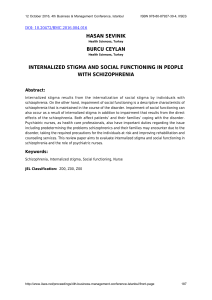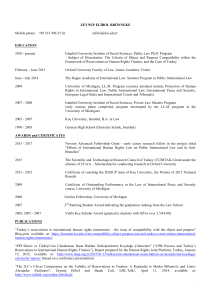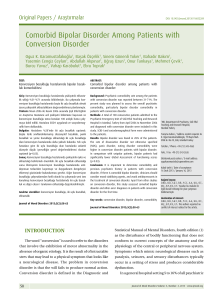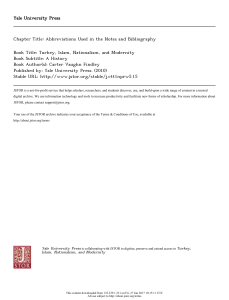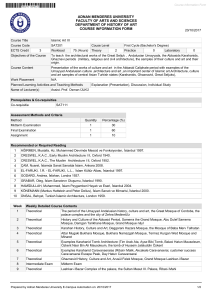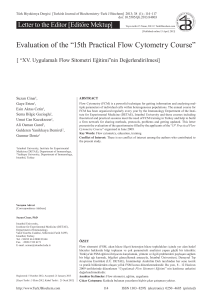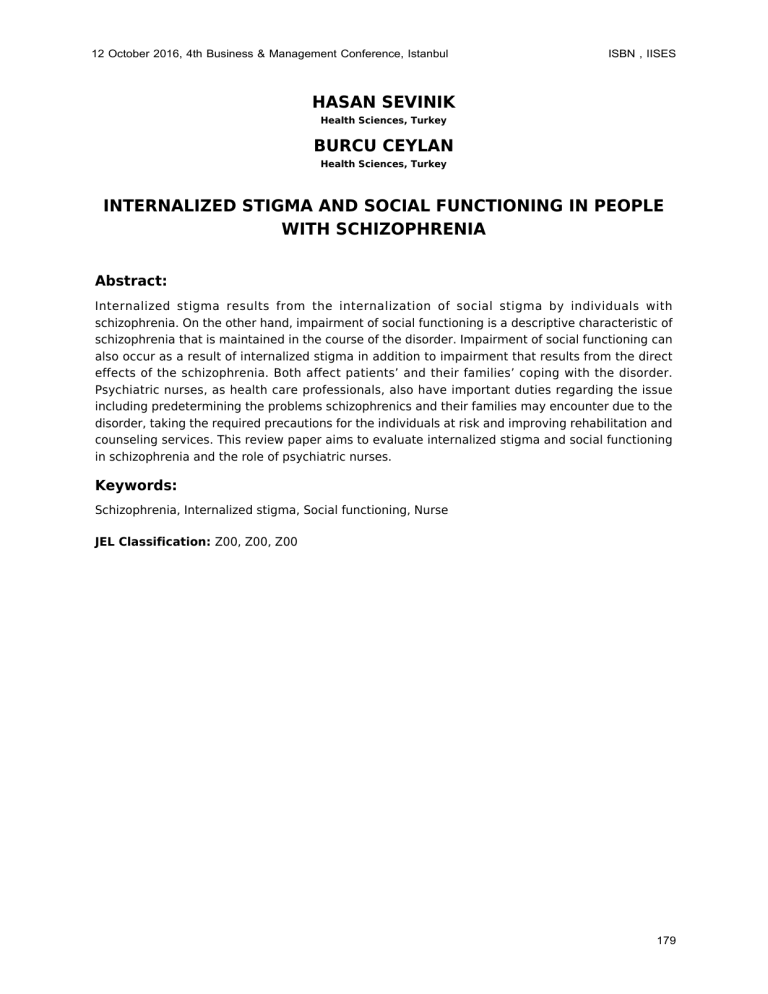
12 October 2016, 4th Business & Management Conference, Istanbul
ISBN , IISES
HASAN SEVINIK
Health Sciences, Turkey
BURCU CEYLAN
Health Sciences, Turkey
INTERNALIZED STIGMA AND SOCIAL FUNCTIONING IN PEOPLE
WITH SCHIZOPHRENIA
Abstract:
Internalized stigma results from the internalization of social stigma by individuals with
schizophrenia. On the other hand, impairment of social functioning is a descriptive characteristic of
schizophrenia that is maintained in the course of the disorder. Impairment of social functioning can
also occur as a result of internalized stigma in addition to impairment that results from the direct
effects of the schizophrenia. Both affect patients’ and their families’ coping with the disorder.
Psychiatric nurses, as health care professionals, also have important duties regarding the issue
including predetermining the problems schizophrenics and their families may encounter due to the
disorder, taking the required precautions for the individuals at risk and improving rehabilitation and
counseling services. This review paper aims to evaluate internalized stigma and social functioning
in schizophrenia and the role of psychiatric nurses.
Keywords:
Schizophrenia, Internalized stigma, Social functioning, Nurse
JEL Classification: Z00, Z00, Z00
179
12 October 2016, 4th Business & Management Conference, Istanbul
ISBN , IISES
Introduction
Schizophrenia is a severe disorder that begins at an early age, condemns the patient
to their inner world by alienating them from social relations and reality. Its leads to
serious disorders in perceptions, thoughts and behavior (Öztürk and Uluşahin, 2011).
It is erroneously, but commonly, believed that mental disorders, including
schizophrenia, occur as a result of personal weakness or are caused by supernatural
powers, and this causes patients to be stigmatized by society (WHO, 2010). Several
studies showed that spirits, ghosts (Burnard et al., 2006), demons, evil eyes (Van de
Put, 2002), magic and religious problems (Van de Put, 2002; Bağ and Ekinci, 2005)
are regarded as factors that cause mental disorders. Social stigma, one of the
important problems of patients with mental disorders (General Directorate of Health
Education of the Ministry of Health, 2008) is considered to be a major issue today.
The word stigma is from Greek and refers to body marks that were designed to
identify morally unusual and blemished individuals (Goffman, 1963). It means
cauterizing the skins of slaves or criminals with a branding iron in order to visibly
identify their guilt or slavery. Stigmatization refers to several behaviors caused by
society’s disapproval for some patient groups and ostracizing them (Kocabaşoğlu and
Aliustaoğlu, 2003).
Stigmatization, on the other hand, does not happen all of a sudden. It occurs in
specific stages: labeling, stereotyping and perception of stigma, respectively.
Labeling: Stigma in mental disorders begins with being diagnosed or labeled with a
mental disorder. Labeling makes us think that these individuals are different (Link and
Phelan, 2001).
Stereotypes: Once labeling stimulates the stereotypes in the society, the
stigmatization process begins. Stereotypes are defined as fixed general ideas or
images. For example, considering someone a mentally ill individual conceptualizes
this person using a stereotype. For individuals with mental disorders, society uses the
stereotypes, which are dangerous and unpredictable. Emotional responses such as
anger and fear occur with stereotypes supported by prejudices (Taşkın, 2007).
Perception of stigma: This means that individuals with mental disorders have a feeling
of being stigmatized without an external or obvious reason. Patients with perception of
stigma may face situations such as failure to maintain their treatment, isolation and
being left unsupported (Taşkın, 2007).
The more a mental disorder is recognized and remarked by society, the more it is
exposed to stigma. Behaviors which are considered to be strange and aggressive by
society increase stigma result in individuals’ being inadequate both in social and
professional fields (Baysal, 2013). Previous studies have reported three types of
180
12 October 2016, 4th Business & Management Conference, Istanbul
ISBN , IISES
stigma including structural (institutional) stigma, social stigma and internalized stigma.
Structural stigma exists at the level of institutions, social stigma exists at the level of
the group, and internalized stigma exists at the individual level (Park et al., 2013).
Internalized stigma is individuals’ resigning themselves to negative stereotypes, and
therefore withdrawing themselves from society with negative feelings such as
worthlessness and shame (Corrigan, 1998). In a sense, perception of stigma refers to
an individual’s feeling stigmatized, whereas internalized stigma refers to selfstigmatization (Baysal, 2013). When patients internalize the stigma against
themselves, their behaviors, personal relationships and preferences change along
with the changes that occur in their inner world. In this case, negatives changes occur
in the self-perception of patients. These changes affect individuals differently. This is
because personal belief systems are developed differently in every culture (Caltaux,
2003).
Internalized stigma is an important matter that is widely observed among
schizophrenia patients and often gets severe (Brohan et al., 2010). A study conducted
with individuals who had been diagnosed with diverse psychiatric disorders found
schizophrenia patients’ levels of internalized stigma to be significantly high (Korkmaz,
2013). Lv et al. (2013) found that 70% of the schizophrenia patients experienced
internalized stigma at moderate levels (Lv et al., 2013). Mosanya indicated that 18.8%
of schizophrenia patients experience internalized stigma at high levels (Mosanya et
al., 2014).
Patients’ internalization of stigma is a barrier to their healing (Chan and Mak, 2014).
Schizophrenia patients who internalize stigma cannot overcome the stereotypes and
expectations of society. Therefore, they have limited social environments, isolate
themselves from the society and may reject treatment (Manojlovic and NikolicPopovic, 2012). Studies conducted with schizophrenia patients showed that different
situations cause patients’ to internalize stigma rather than a single factor. In these
studies, characteristics such as education level (Coşkun and Güven Caymaz, 2012;
Lv et al., 2013; Mosanya et al., 2014), duration of disorder, employment status (Lv et
al., 2013; Mosanya et al., 2014), total number of hospitalizations, social support status
(Lv et al., 2013), income status (Coşkun and Güven Caymaz, 2012; Mosanya et al.,
2014) and status of hospitalization at psychiatry clinics (Coşkun and Güven Caymaz,
2012) were found to be associated with the internalization of stigma.
Society not only stigmatizes schizophrenia patients, it also tends to stop
communicating with them and including them in social relations. Patients’ attempt to
conceal their mental disorders for fear of being stigmatized results in their alienation
from social environments. Patients’ social functioning, professional functioning and so
forth (excess and inadequacy symptoms) are as important as schizophrenia
symptoms. This is because declines are observed along with the disorder in patients’
areas of functioning, such as their jobs, interpersonal relations and personal care
181
12 October 2016, 4th Business & Management Conference, Istanbul
ISBN , IISES
(Yıldız, 2011). Individuals’ losing interest in the outside world results in a decrease in
their interaction with their families and friends, and they prefer to be alone. Individuals’
functions, such as personal care and hygiene deteriorate, and they cannot maintain a
regular business or school life (Köroğlu and Güleç, 2007). This deterioration prevents
individuals from developing social relationships and it also prevents their social
requirements from being satisfied. Individuals’ relationships with their colleagues,
friends and families; their career and productivity are interrupted. Functioning, a
learned concept with the society and skills can be shaped with education. Since
schizophrenia occurs at an age at which social skills are gained, patients may not gain
them at the right time. Extended hospital stays and living alone can prevent patients
from developing new social skills and cause existing skills to be forgotten (Yıldız,
2011). Besides the pharmacological treatment provided to eliminate symptoms in the
course of the treatment of the disorder, patients’ functioning levels should also be
preserved (Tatlıdil et al., 2009). To achieve this, approaches in social treatment for
mental disorders have been given major consideration (Ensari et al., 2013). Yıldız et
al. (2015) determined considerable improvements in patients’ social functioning with a
program helping psychosocial skill development among schizophrenia patients.
Sönmez (2009) found a significant increase in patients’ functioning levels as a result
of psychoeducation provided to them. Patients’ noticing that other people also have
similar problems to theirs and sharing their problems with others by trusting them are
thought to contribute their social functioning.
The Roles of the Nurses in Preventing the Stigmatization of Schizophrenia
Patients and Maintaining Social Functioning
Nurses are constantly in peer-to-peer interaction with people, and they are
responsible for protecting individuals in society from diseases and promoting and
improving their existing health status. Thus, nurses are the health care professionals
who enable individuals’ physical, social and emotional needs to be satisfied (Özcan,
2006). Nurses who have the opportunity to spend enough time with schizophrenia
patients in the process of their adaptation to society and communicate with them can
stand by these patients for a long time in treatment and rehabilitation from the onset of
the disorder. Therefore, they are more likely to help the patients than other health care
professionals (Ergün, 2005).
Coping with schizophrenia is one of the basic challenges for patients and their
families. Being familiar with the disorder, appreciating the continuity and necessity of
the prognosis and treatment or uncertainty about the disorder are important issues for
schizophrenia. Although being familiar with and controlling their own health is a
prerequisite for individuals, schizophrenia patients may remain incapable of managing
their own health. Here, nurses are responsible for helping patients manage their own
health and satisfy their needs independently. This can only be achieved by providing
education and continuous support (Videbeck, 2011).
182
12 October 2016, 4th Business & Management Conference, Istanbul
ISBN , IISES
Patients may isolate themselves from the social life in the outside world for a variety of
reasons along with their disorder. Patients who have hallucinations or delusions and
who behave and speak oddly may frighten and embarrass their families and others.
Patients who have doubts and whose sense of trust is not developed may avoid
communicating with others. Patients may also have speaking and social skill
inadequacies and be unable to establish and maintain relationships with others.
Nurses can improve the social skills of patients or teach them to talk about a social
topic such as the weather forecast or local issues in an appropriate way by providing
education, being a role model and practicing with them. Showing patients social skills
and practicing them can bring them more successful experiences in social interaction
areas, whereas skills, such as making an eye contact, listening carefully and facing
the addressee can improve patients’ self-confidence and talents (Videbeck, 2011).
Unless the excess symptoms of the disorder, in particular, are eliminated, patients are
continuously exposed to stigmatization (Videbeck, 2011). Preventive studies of mental
disorders is an important issue that should be taken into consideration since patients
do not seek care in psychiatry clinics for fear of being stigmatized and avoid
treatment. Through the nursing initiatives to be practiced for the early diagnosis and
treatment of the disorders, this type of disorders can be detected early. Consequently,
the treatment process can be shortened, and therefore both patients’ and families’
fear of and concern about labeling can be handled early. Psychiatric nurses’ detection
of the patients’ current situation and providing them with counseling for stigmatization
can prevent the negative effects of stigmatization on counselees and patients
(Sarıkoç, 2011).
REFERENCES
BAĞ, B and EKİNCİ, M. (2005). Sağlık personelinin ruhsal sorunları olan bireylere yönelik tutumlarının
araştırılması. Elektronik Sosyal Bilimler Dergisi, 3(11), 107-27.
Baysal GÖD, 2013. Damgalanma ve ruh sağlığı. Arşiv Kaynak Tarama Dergisi, 22(2), 239-51.
BROHAN, E.; SLADE, M.; CLEMENT, S and THORNİCROFT G. (2010). Experiences of mental illness
stigma, prejudice and discrimination: a review of measures. BMC Health Services Research,
10:80.
BURNARD, P.; NAİYAPATANA, W and LLOYD, G. (2006). Views of mental illness and mental health
care in Thailand: a report of an ethnographic study. Journal of Psychiatric and Mental Health
Nursing, 13(6), 742–9.
CALTAUX, D. (2003). Internalized stigma: a barrier to employment for people with mental illness. Int J
Ther Rehabil, 10(12), 539-43.
183
12 October 2016, 4th Business & Management Conference, Istanbul
ISBN , IISES
CHAN, KKS and MAK, WWS. (2014). The mediating role of self stigma and unmet needs on the
recovery of people with schizophrenia living in the community. Qual Life Res, 23, 2559-68.
CORRIGAN, P. (1998). The impact of stigma on severe mental illness. Cogn Behav Pract, 5, 201-22.
COŞKUN, S and GÜVEN CAYMAZ, N. (2012). Bir kamu ve özel psikiyatri hastanesine başvuran
hastaların içselleştirilmiş damgalanma düzeyi yönünden karşılaştırılması. Psikiyatri Hemşireliği
Dergisi, 3(3), 121-8.
ENSARİ, H.; GÜLTEKİN, BK.; KARAMAN, D.; KOÇ, A and BEŞKARDEŞ, AF. (2013). Bolu toplum ruh
sağlığı merkezi hizmetlerinin şizofreni hastalarındaki yaşam kalitesi, yeti yitimi, genel ve sosyal
işlevsellik üzerine etkisi: Bir yıllık izleme sonuçları. Anadolu Psikiyatri Derg, 14, 108-14.
ERGÜN, G. (2005). Psikiyatri servislerinde çalışan hemşirelerin şizofreni tanısı almış bireylere bakış
açıları. Yayımlanmamış Yüksek Lisans Tezi, Akdeniz Üniversitesi Sağlık Bilimleri Enstitüsü,
Antalya.
GENERAL DIRECTORATE OF HEALTH EDUCATION OF THE MINISTRY OF HEALTH. 2008.
Eğitimciler için eğitim rehberi: Ruh sağlığı modülleri, Ankara. Yayın no: 722.
GOFFMAN, E. (1963). Stigma: The management of spoiled identity, UK: Penguin, Harmondsworth.
KOCABAŞOĞLU, N and ALİUSTAOĞLU, S. (2003). Stigmatizasyon. Yeni Symposium, 41(4), 190-2.
KORKMAZ, G. (2013). Akut psikiyatri servislerinde yatan hastalarda içselleştirilmiş stigma ve algılanan
aile desteği. Yayınlanmamış Yüksek Lisans Tezi, İstanbul Üniversitesi Sağlık Bilimleri Enstitüsü,
İstanbul.
KÖROĞLU, E and GÜLEÇ, C. (2007). Psikiyatri Temel Kitabı, İkinci baskı, Ankara, Hekimler Yayın
Birliği.
LINK, BG and PHELAN, JC. (2001). Conceptualizing stigma. Annu Rev School, 27, 363-85.
LV, Y.; WOLF, A and WANG, X. (2013). Experienced stigma and self-stigma in Chinese patients with
schizophrenia. General Hospital Psychiatry, 35, 83-8.
MANOJLOVİC, SD and POPOVİC, JMN. (2012). İnternalized stigmaand self esteem in schizophrenic
patients. Europan Psychiatry, 27(1), 1.
MOSANYA, TJ.; ADELUFOSİ, AO.; ADEBOWALE, OT.; OGUNWALE, A and ADEBAYO, OK. (2014).
Self stigma, quality of life and schizophrenia: An outpatient clinic survey in Nigeria. İnrernational
Journal of Social Psychiatry, 60(4), 377-86.
ÖZCAN, A. (2006). Hemşire- hasta ilişkisi ve iletişim. 2. Baskı, Sistem Ofset Basın Yayın, Ankara.
184
12 October 2016, 4th Business & Management Conference, Istanbul
ISBN , IISES
ÖZTÜRK, MO and ULUŞAHİN, A. (2011). Ruh sağlığı ve bozuklukları-I, On birinci baskı, Ankara, Nobel
Tıp Kitabevleri.
PARK, SG.; BENNETT, ME.; COUTURE, SM and BLANCHARD, JJ. (2013). İnternalized stigma in
schizophrenia: Relations with dysfunctional attitudes, symptoms and quality of life. Psychiatry
Research, 205, 43-7.
SARIKOÇ, G. (2011). Ruhsal sorunları nedeniyle ayaktan izlenen hastaların içselleştirilmiş
etiketlenmeleri. Yayımlanmamış Yüksek Lisans Tezi, Hacettepe Üniversitesi Sağlık Bilimleri
Enstitüsü, Ankara.
SONMEZ, S. (2009). Şizofreni hastalarında psikoeğitim grup çalışmasının pozitif ve negatif belirtiler,
sosyal işlevsellik, yeti yitimi, içgörü ve yaşam kaltesi üzerine etkilerinin araştırılması. Uzmanlık
Tezi, Bakırköy Prof. Dr. Mazhar Osman Ruh Sağlığı ve Sinir Hastalıkları Eğitim ve Araştırma
Hastanesi 2. Psikiyatri birimi, İstanbul.
TASKIN, EO. (2007). Ruhsal hastalıklarda damgalama ve ayrımcılık. In: Stigma, Ruhsal hastalıklara
yönelik tutumlar ve damgalama, İzmir,17-30.
TATLIDIL, E.; YILMAZ, A and GOGUS, AK. (2009). Şizofreni tanılı hastalarda semptomatolojinin sosyal
işlevsellik üzerine etkisi. Klinik Psikofarmakoloji Bülteni, 19 (Suppl. 1), 111-3.
VAN DE PUT, W. (2002). Addressing mental health in Afghanistan. The Lancet, 360, 41- 2.
VİDEBECK, SL. (2011). Psychiatric mental health nursing. Fifth edition. Lippincott Williams and Wilkins
press. Philadelphia, USA.
WORLD HEALTH ORGANİZATİON. (2010). Mental health and development: Targeting people with
mental health conditions as a vulnerable group, Geneva.
WORLD HEALTH ORGANİZATİON. (2001). Mental Health: New understanding, New hope. The World
Health Report, Geneva.
YILDIZ, M. (2011). Şizofreni hastaları için ruhsal toplumsal beceri eğitimi, Birinci baskı, Ankara, Türkiye
Sosyal Psikiyatri Derneği Yayınları.
YILDIZ, M.; VEZNEDAROĞLU, B.; ERYAVUZ, A and KAYAHAN, B. (2015). Psychosocial skills training
on social functioning and quality of life in the treatment of schizophrenia: a controlled study in
Turkey. Int J Psych Clin Pract,8, 219-25.
185

